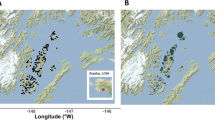Abstract
The supertankerUrquiola grounded, exploded, and burned at the entrance to La Coruña harbor (Spain) on May 12, 1976. A total of 100,000 tons of Persian Gulf crude oil was lost, of which about 30,000 tons washed onto shoreline environments. From May 17 to June 10, 1976, the impact and interaction of oil on fine-sand, coarse-sand, and gravel beaches and on sheltered and exposed rocky coasts was monitored in detail. At 32 localities, the beach was profiled, trenched, extensively sampled, and photographed. Another 67 stations were examined for surficial oil coverage and distribution. The surficial distribution of oil on the beaches was influenced primarily by wave activity, tidal stage, and oil quantity. Heaviest accumulations formed along the high-tide swash line. Within beach sediments, oil was present at distinct oiled sediment layers, which were often deeply buried. The depth of burial was related to wave energy and sediment type. Deepest burial (1 m) was on a high-energy, coarse-sand beach (Mz=0.82φ). Burial on fine-sand beaches was less than 30 cm. The thickness of oiled sediment depended on sedimentary characteristics, the quantity of oil present, wave action, and capillary forces. Oil-soaked sediment, as much as 65-cm thick, occurred on coarse-grained beaches. On fine-sand beaches, oiled sediment was limited to thicknesses of 10 cm or less. On rocky shores, oil distribution was determined primarily by wave energy. Along high-energy, cliffed, or steeply dipping rocky areas, wave reflection kept the oil approximately 5 m offshore and contamination was minimal. In low-energy, sheltered areas, oil readily accumulated, causing apparent environmental damage.
Similar content being viewed by others
References
Aguilar, S. A. de Ediciones, 1961, Nuevo atlas de España: Madrid, Aguilar, S. A. de Ediciones, 455 p.
Folk, R. L., 1968, Petrology of sedimentary rocks: Austin, Texas, Hemphill's Pub., 170 p.
Foster, M., A. C. Charters, and M. Neushul, 1971, The Santa Barbara oil spill, Part I, initial quantities and distribution of pollutant crude oil: Environ. Pollut., v. 2, pp. 97–113.
Gundlach, E. R., and M. O. Hayes, 1977, theUrquiola oil spill, La Coruña, Spain; case history and dicussion of methods of control and clean-up: Mar. Pollut. Bull., v. 8, no. 6, pp. 132–136.
Gundlach, E. R., I. A. Fischer, and R. J. Stein, 1977, The black tide of La Coruña: Oceans, v. 10, no. 2, pp. 56–60.
Hann, R. W. Jr., 1974, Oil pollution from the tankerMetula: Texas A&M Univ., Civil Engineering Dept., Report to the United States Coast Guard, 61 p.
Hayes, M. O., and E. R. Gundlach, 1975, Coastal geomorphology and sedimentation of theMetula oil spill site in the Strait of Magellan: Univ. South Carolina, Coastal Research Division, Report to Advanced Environmental Research and Tchnology-National Science Foundation, 103 p.
IHM, 1975, Anuario de mareas—1976: Cadiz, Spain, Instituto Hidrografico de la Marina, p. 27–29.
Kolpack, R. L., 1971, Biological and oceanographical survey of the Santa Barbara oil spill: Ch. 2, pp. 7–13.
NOAA, 1977, TheArgo Merchant oil spill, a preliminary report: Boulder, Colorado, National Oceanic and Atmospheric Administration, Environmental Res. Lab., 133 p.
Owens, E. H., 1971, The restoration of beaches contaminated by oil in Chedabucto Bay, Nova Scotia: Ottawa, Can., Marine Sci. Branch, Manuscript Rep. Ser., No. 19, 75 p.
Owens, E. H., and M. A. Rashid, 1976, Coastal environments and oil spill residues in Chedabucto Bay, Nova Scotia: Can. Jour. Earth Sci., v. 13, pp. 908–928.
Sartor, J. D., and C. R. Foget, 1971, Evaluation of selected earthmoving equipment for the restoration of oil-contaminated beaches: Am. Petrol. Inst., Proc. Joint Conf. on Prevention and Control of Oil Spills, pp. 505–522.
Smith, J. E., 1968,Torrey Canyon, pollution and marine life: New York, Cambridge Univ. Press, 196 p.
Author information
Authors and Affiliations
Rights and permissions
About this article
Cite this article
Gundlach, E.R., Ruby, C.H., Hayes, M.O. et al. TheUrquiola oil spill, La Coruña, Spain: Impact and reaction on beaches and rocky coasts. Geo 2, 131–143 (1978). https://doi.org/10.1007/BF02430667
Issue Date:
DOI: https://doi.org/10.1007/BF02430667




